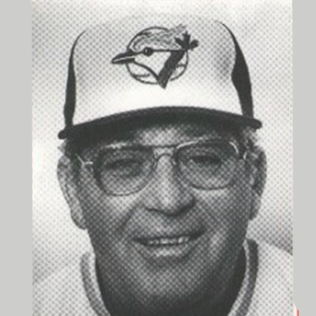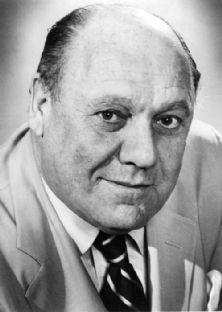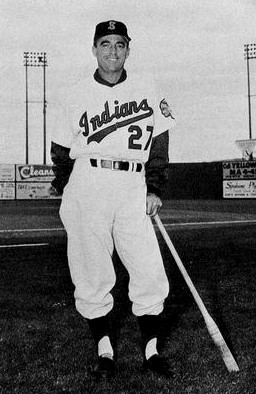Related Research Articles

Robert James Mattick was an American professional baseball player, scout, and manager. He played in Major League Baseball (MLB) as a shortstop for the Chicago Cubs and Cincinnati Reds. After his playing career, he most notably worked in the Toronto Blue Jays organization, including two seasons as the team's manager.

Emil Joseph "Buzzie" Bavasi was an American executive in Major League Baseball who played a major role in the operation of three California baseball franchises from the late 1940s through the mid-1980s.

Lafayette Fresco Thompson Jr. was an American Major League Baseball second baseman and executive. Thompson was born in Centreville, Alabama. In 1916, when he was 14, his family moved to New York City, where Thompson attended George Washington High School and Columbia University. At Columbia, he was a football teammate of Lou Gehrig's, but Thompson left the school to turn professional before he could join Gehrig on the Lions' baseball team.

Roy Thomas Hartsfield was an American second baseman and manager in Major League Baseball; his MLB playing and managing careers each lasted three years. Hartsfield played his entire major league career with the Boston Braves from 1950 to 1952. He was then traded to the Brooklyn Dodgers for outfielder Andy Pafko.

Preston Gómez was a Cuban-born infielder, manager, coach and front-office official in Major League Baseball best known for managing three major league clubs: the San Diego Padres (1969–72), Houston Astros (1974–75) and Chicago Cubs (1980). He was born Pedro Gómez Martínez in Central Preston, Cuba, and was given his nickname in U.S. professional baseball from his birthplace.
The Nashua Dodgers was a farm club of the Brooklyn Dodgers, operating in the class-B New England League between 1946 and 1949. It is believed to be the first professional baseball team based in the United States in the twentieth century to play with a racially integrated roster. The team was based at Holman Stadium in Nashua, New Hampshire.

William Joseph Bavasi is an American former Major League Baseball general manager. He currently works as director of the Major League Baseball Scouting Bureau, appointed in November 2014. Bavasi previously served as an assistant to the GM for the Cincinnati Reds, under Reds general manager Walt Jocketty. The son of longtime MLB executive Buzzie Bavasi and the brother of Peter Bavasi, also a former MLB executive, Bill also spent six full seasons (1994–99) as the general manager of the California/Anaheim Angels and a 4+1⁄2 season stint as GM of the Seattle Mariners (2003–08).
The 1992 Toronto Blue Jays season was the franchise's 16th season of Major League Baseball. Toronto finished first in the American League East for the fourth time with a record of 96 wins and 66 losses, closing the season with an attendance record of 4,028,318. Toronto was not swept in a single series all year, becoming the first team in 49 years to accomplish the feat.
The 1991 Toronto Blue Jays season was the franchise's 15th season of Major League Baseball. It resulted in the Blue Jays finishing first in the American League East with a record of 91 wins and 71 losses. The team's paid attendance of 4,001,527 led the major leagues, as the Jays became the first team in MLB history to draw four million fans in a season. Toronto lost the ALCS to the eventual world champion Minnesota Twins in five games.
The 1989 Toronto Blue Jays season was the franchise's 13th season of Major League Baseball. It resulted in the Blue Jays finishing first in the American League East with a record of 89 wins and 73 losses. The Blue Jays' ace pitcher Dave Stieb led the staff with 17 victories, and the team was offensively buoyed by the league's home run king Fred McGriff. Toronto won the AL East pennant in the final weekend of the season against the favored Baltimore Orioles. The Blue Jays lost the ALCS in five games to the eventual World Series champion Oakland Athletics. It was the team's last season at Exhibition Stadium, before moving to SkyDome halfway into the season. The Blue Jays hit eight grand slams, the most in MLB in 1989.
The 1982 Toronto Blue Jays season was the franchise's sixth season of Major League Baseball. It resulted in the Blue Jays finishing sixth in the American League East with a record of 78 wins and 84 losses, 17 games behind the American League Champion Milwaukee Brewers. Bobby Cox became the third field manager in team history.
The 1981 Toronto Blue Jays season was the franchise's fifth season competing in Major League Baseball. Games were suspended for 50 days due to the 1981 Major League Baseball strike, causing a split season. The Blue Jays finished both halves of the season in seventh place in the seven-team American League East. Managed by Bobby Mattick, the Blue Jays played their home games at Exhibition Stadium and had an overall record of 37 wins and 69 losses.
The 1979 Toronto Blue Jays season was the franchise's third season of Major League Baseball. It resulted in the Blue Jays finishing seventh in the American League East with a record of 53 wins and 109 losses. The Blue Jays were the only American League East team to finish 1979 with a losing record and the loss total of 109 set the franchise mark; it is also the last time as of 2023 the team lost over 100 games in a season. Attendance for the season decreased to 1,431,651.
The 1977 Toronto Blue Jays season was the first season of Major League Baseball played by the Toronto-based expansion franchise. The Blue Jays finished seventh in the American League East with a record of 54 wins and 107 losses, 45½ games behind the World Champion New York Yankees.
Tommy Douglas Dean is an American former professional baseball player. A shortstop, his career extended from 1964–71 and included 215 games played in Major League Baseball over four seasons. Dean was listed at 6 feet (1.8 m) tall and 165 pounds (75 kg), and threw and batted right-handed.
The 1991 San Diego Padres season was the 23rd season in franchise history.
Robert Marcel Fontaine was an American professional baseball player, scout and executive. The native of San Jose, California, a World War II veteran, was the first director of scouting for the San Diego Padres of the National League, and served as the third general manager in the history of San Diego's Major League franchise.
Edwin William Leishman was an American professional baseball player, manager and executive. He was the first general manager of the San Diego Padres when they joined Major League Baseball, serving from late 1968 until 1972. Immediately before, Leishman had been the GM of the Triple-A, Pacific Coast League edition of the Padres from 1960 to 1968.
References
- ↑ "Peter Bavasi" at the Baseball America Executive Database
- ↑ "Bill Bavasi" at the Baseball America Executive Database
- 1 2 3 4 5 6 Diamond Dreams: 20 Years of Blue Jays Baseball, Stephen Brunt, p. 64, Penguin Books, ISBN 0-14-023978-2
- ↑ Diamond Dreams: 20 Years of Blue Jays Baseball, Stephen Brunt, p. 69, Penguin Books, ISBN 0-14-023978-2
- 1 2 Blue Jays Timeline
- 1 2 The Beaver Bites Back?: American Popular Culture in Canada, p. 159, David H. Flaherty, Frank E. Manning, McGill-Queen's University Press (December 1993), ISBN 0-7735-1120-2
- ↑ Diamond Dreams: 20 Years of Blue Jays Baseball, Stephen Brunt, p. 70, Penguin Books, ISBN 0-14-023978-2
- ↑ Diamond Dreams: 20 Years of Blue Jays Baseball, Stephen Brunt, p. 136, Penguin Books, ISBN 0-14-023978-2
- ↑ Diamond Dreams: 20 Years of Blue Jays Baseball, Stephen Brunt, p. 137, Penguin Books, ISBN 0-14-023978-2
- ↑ Diamond Dreams: 20 Years of Blue Jays Baseball, Stephen Brunt, p. 157, Penguin Books, ISBN 0-14-023978-2
- 1 2 Principals Archived 2007-08-04 at the Wayback Machine
- 1 2 New York Times, January 24, 1987